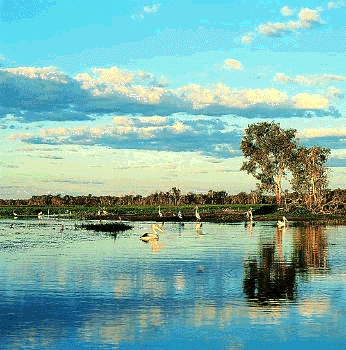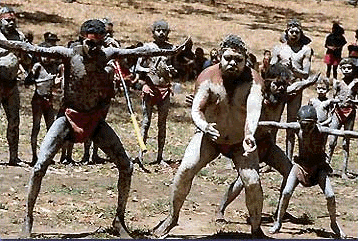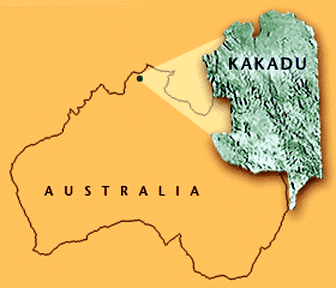 |
http://www.deh.gov.au/parks/kakadu/ imagegallery/landscapepics.html |
The Wetlands and Native Peoples of Northern Australia
Thanks to a variety of climatic zones, Northern Australia is home to a diversity of wetlands, and consequently, a great variety of plants and animals which are a part of these wondrous ecosystems. Likewise, Northern Australia is also home to Aboriginal peoples who have kept their cultural traditions for tens of thousands of years, and who depend on the wetlands for their own survival. Hence, while the wetlands and its creatures rely on mankind for their own survival, in response, the wetlands are providers of life sustenance for the peoples that inhabit these regions.
Because the area has largely remained undeveloped and unindustrialized, and because of the presence of native human inhabitants, Northern Australia thrives as a land of wetland conservation, and is a striking example of peaceful coexistence with nature.
Harmonious Coexistence
But it is not to say that the wetlands of Northern Australia are not threatened ecosystems. As with most all wetlands, natural factors and human actions pose a threat to their long-term survival. While some humans have threatened these treasures of nature with excessive land development for industry and agriculture, with unfriendly practices, and with uneco-friendly tourism, the Aboriginal peoples of Australia's wetlands have peacefully and fruitfully coexisted with these lands for thousands of years. The nourishing wetlands have created a nurturing relationship with the native Australian peoples, breeding a conservationalist mentality and lifestyle which has survived the test of time, industry, and world economy.
 |
http://www.calacademy.org/ research/anthropology/tap/Au7-dp.jpg |
Conservation in Action
“The park represents a series of interacting ecosystems that continue to evolve in their natural setting with minimum human disturbance."
One such example of harmonious coexistence between the native peoples of a region and the wetlands, themselves, is Kakadu National Park which covers a total area of almost 20,000 square kilometers in Northern Australia, and is a unique archaeological, ethnological, biological, and ecological preserve. The park is owned by Aboriginal peoples, also known as the Kakadu, and managed by an Aboriginal majority representing those traditional owners, along with the Department of Environment and Heritage. Hence, the native peoples of the land have immense input on policy and development, tourism and day-to-day activities, as well as on the long-term environmental well-being of the region.
To the Aboriginal people, Kakadu is more than just a national park, it is vital to their communities which still occupy the region, their future as a people, and their historical preservation. Also famous for its cave paintings and rock carvings, the park serves as a record of the area's inhabitants, from the hunter-gatherers of prehistoric times to the Aboriginal people who still inhabit the land, and of their long-term interaction with the environment. Hence, their love for a region which has sustained them for at least 25,000 and possibly 40,000-60,000 years also ensures that they will protect it.
 |
http://www.pbs.org/edens/kakadu/seasons.html |
In Kakadu, during the wet season, rivers flood and spread out over the flood plains, forming extensive wetlands, where fowl abound. These wetlands are considered 'Wetlands of International Importance Especially as Waterfowl Habitat' by the Ramsar Convention. Home to more than 10,000 species of insects, Kakadu, as with other wetlands, has often been naively mistaken by those unfamiliar with the benefits of flood plain and swamp-type wetlands, as ‘mosquito breeding grounds.’ But the park is also home to more than 60 species of mammals, 289 bird species, 132 reptile species, 25 frog species, and 55 species of freshwater fish, and a plethora of plant life. Hence, these creatures also depend on the Aboriginal peoples and their work to environmentally sustain the region.
Kakadu has thrived because of the input of the native peoples, their knowledge of the land and its needs, its natural patterns, seasonal and historical changes, animal and plant life, and the like, creating a unique relationship in which those who understand the land best, can offer modern-day scientists, researchers, and developers, constant input on the land’s current and future use and sustainability.
Page created on 3/18/2005 12:40:43 PM
Last edited 3/20/2018 8:57:36 PM
Throughout history, the Northern Australian wetlands have offered (amongst other things) the Aboriginal peoples of the area:
* Fruit from the native mistletoe, the sweet slender grape, and 'kuta' honey from the native bee, to eat.
* In the arid desert regions, the rock fig to be made into dried cakes for survival.
* The Swamp Paperbark bark - which can be stripped off like cork without damaging the tree - and used for shelter, containers, cooking and more.
* The dianella lily leaves and reed grass, used to make traps to catch the orange-fingered Yabby.
* And animals to hunt and eat for survival like the 'chibur' squirrel glider, the 'Bugawan'osprey, and 'du-wir' brown quail.
